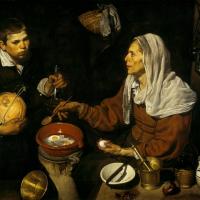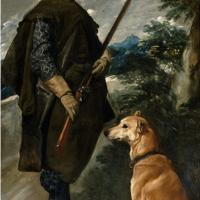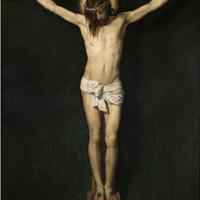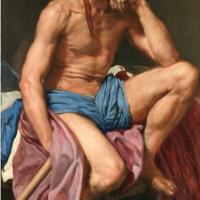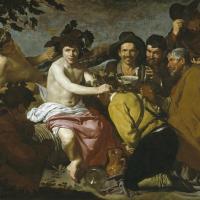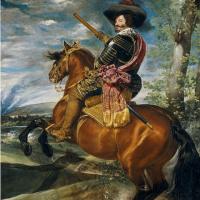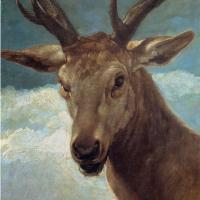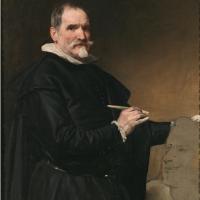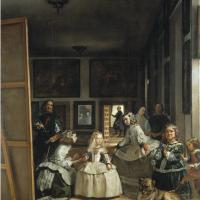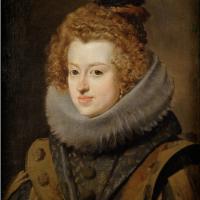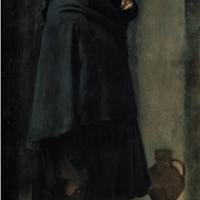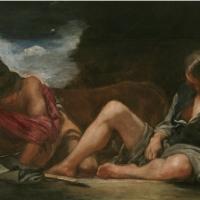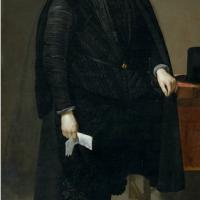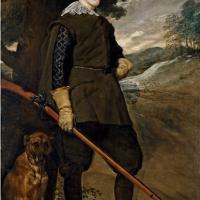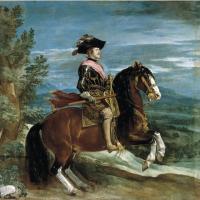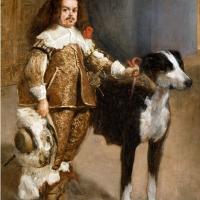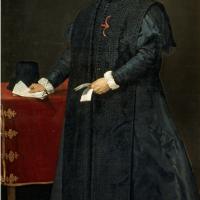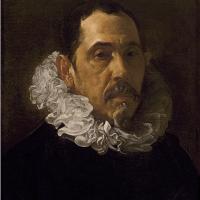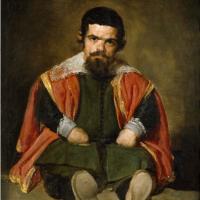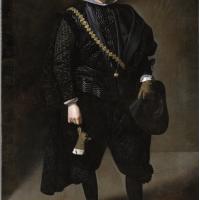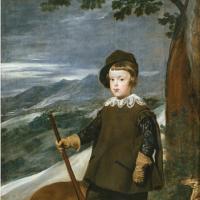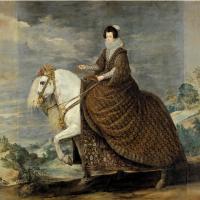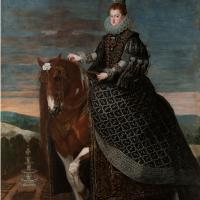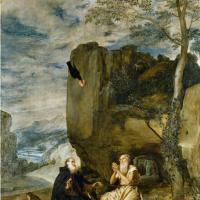Diego Velazquez
An Old Woman Cooking Eggs
$540.00
Christ Crucified With Donor
$480.00
El Dios Marte
$480.00
Head Of A Buck
$480.00
Juan Martinez Montanes
$480.00
Las Meninas
$480.00
Maria Anna of Spain
$480.00
Menippus
$480.00
Mercury And Argus
$480.00
Philip IV
$480.00
Philip IV In Hunting Costume
$480.00
Philip IV On Horseback
$540.00
Diego Velazquez
Diego Velazquez (1599-1660)
Diego Rodríguez de Silva y Velázquez (baptized June 6, 1599 – August 6, 1660) was a Spanishpainter, the leading artist in the court of King Philip IV, and one of the most important painters of the Spanish Golden Age. He was an individualistic artist of the contemporary Baroque period. In addition to numerous renditions of scenes of historical and cultural significance, he painted scores of portraits of the Spanish royal family, other notable European figures, and commoners, culminating in the production of his masterpiece Las Meninas (1656).
From the first quarter of the nineteenth century, Velázquez's artwork was a model for the realist and impressionist painters, in particular Édouard Manet. Since that time, famous modern artists, including Pablo Picasso, Salvador Dalíand Francis Bacon, have paid tribute to Velázquez by recreating several of his most famous works.
Velázquez was educated by his parents to fear God and, intended for a learned profession, received good training in languages and philosophy. Influenced by many artists, he showed an early gift for art; consequently, he began to study under Francisco de Herrera, a vigorous painter who disregarded the Italian influence of the early Seville school. Velázquez remained with him for one year. It was probably from Herrera that he learned to use brushes with long bristles.
After leaving Herrera's studio when he was 12 years old, Velázquez began to serve as an apprentice under Francisco Pacheco, an artist and teacher in Seville. Though considered a generally dull, undistinguished painter, Pacheco sometimes expressed a simple, direct realism in contradiction to the style of Raphael that he was taught. Velázquez remained in Pacheco's school for five years, studying proportion and perspective and witnessing the trends in the literary and artistic circles of Seville.
By the early 1620s, his position and reputation were assured in Seville.
Through the bust portrait of the king, painted in 1623, Velázquez secured admission to the royal service, with a salary of 20 ducats per month, besides medical attendance, lodgings and payment for the pictures he might paint. The portrait was exhibited on the steps of San Felipe and was received with enthusiasm. It is now lost. The Museo del Prado, however, has two of Velázquez's portraits of the king (nos. 1070 and 1071) in which the severity of the Seville period has disappeared and the tones are more delicate. The modeling is firm, recalling that of Antonio Mor, the Dutch portrait painter of Philip II, who exercised a considerable influence on the Spanish school. In the same year, the Prince of Wales (afterwards Charles I) arrived at the court of Spain. Records indicate that he sat for Velázquez, but the picture is now lost. In September 1628, Peter Paul Rubens came to Madrid as an emissary from the Infanta Isabella, and Velázquez accompanied him to view the Titiansat the Escorial. Rubens was then at the height of his powers. The seven months of the diplomatic mission showed Rubens' brilliance as painter and courtier. Rubens had a high opinion of Velázquez, but he had no significant influence on his painting. He reinforced Velázquez's desire to see Italy and the works of the great Italian masters.
Until the nineteenth century, little was known outside of Spain of Velázquez's work. His paintings mostly escaped being stolen by the French marshals during the Peninsular War. In 1828, Sir David Wilkie wrote from Madrid that he felt himself in the presence of a new power in art as he looked at the works of Velázquez, and at the same time found a wonderful affinity between this artist and the British school of portrait painters, especially Henry Raeburn. He was struck by the modern impression pervading Velázquez's work in both landscape and portraiture. Presently, his technique and individuality have earned Velázquez a prominent position in the annals of European art, and he is often considered a father of the Spanish school of art. Although acquainted with all the Italian schools and a friend of the foremost painters of his day, he was strong enough to withstand external influences and work out for himself the development of his own nature and his own principles of art.
Velázquez is often cited as a key influence on the art of Édouard Manet, important when considering that Manet is often considered the bridge between realism and impressionism. Calling Velázquez the "painter of painters", Manet admired Velázquez's use of vivid brushwork in the midst of the Baroque academic style of his contemporaries and built upon Velázquez's motifs in his own art.
The importance of Velázquez's art even today is evident in considering the respect with which twentieth century painters regard his work. Pablo Picasso presented the most durable homages to Velázquez in 1957 when he recreated Las Meninas in 58 variations, in his characteristically cubist form. Although Picasso was concerned that his reinterpretations of Velázquez's painting would be seen merely as copies rather than unique representations, the enormous works—including the largest he had produced since Guernica in 1937—obtained a position of importance in the canon of Spanish art. Picasso retained the general form and positioning of the original in the context of its avant-garde cubist style.
Salvador Dalí, as with Picasso in anticipation of the tercentennial of Velázquez's death, created in 1958 a work entitled Velázquez Painting the Infanta Margarita With the Lights and Shadows of His Own Glory. The color scheme shows Dalí's serious tribute to Velázquez; the work also functioned, as in Picasso's case, as a vehicle for the presentation of newer theories in art and thought—nuclear mysticism, in Dalí's case.
The Anglo-Irish painter Francis Bacon found Velázquez's portrait of Pope Innocent X to be one of the greatest portraits ever made. He created several expressionist variations of this piece in the 1950s; however, Bacon's paintings presented a more gruesome image of the pope, who had now been dead for centuries. One such famous variation, entitled Figure with Meat(1954), shows the pope between two halves of a bisected cow.
In 2009, the Portrait of a Man in the collection of the Metropolitan Museum of Art, which had long been associated with the followers of Velázquez' style of painting, was cleaned and restored. It was found to be by Velázquez himself, and the features of the man match those of a figure in the painting "the Surrender of Breda". The newly cleaned canvas may therefore be a study for that painting. Although the attribution to Velázquez is regarded as certain, the identity of the sitter is still open to question. Some art historians regard this new study to be a self-portrait by Velázquez.
In 2010 it was reported that a damaged painting long relegated to a basement of the Yale University Art Gallery might be an early work by Velázquez. Thought to have been given to Yale in 1925, the painting has previously been attributed to the 17th-century Spanish school. Some scholars are prepared to attribute the painting to Velázquez, though the Prado Museum in Madrid is reserving judgment. The work, which depicts the Virgin Mary being taught to read, will be restored by conservators at Yale.
In October 2011 it was confirmed by art historian Dr. Peter Cherry of Trinity College Dublin through x-ray analysis that a portrait found in the UK in the former collection of the 19th-century painter Matthew Shepperson is a previously unknown work by Velázquez. The portrait is of an unidentified man in his fifties or sixties, who could possibly be Juan Mateos, the Master of the Hunt for Velázquez's patron, King Philip IV of Spain. The painting measures 47 x 39 cm and was sold at auction on December 7, 2011, for £3,000,000.


